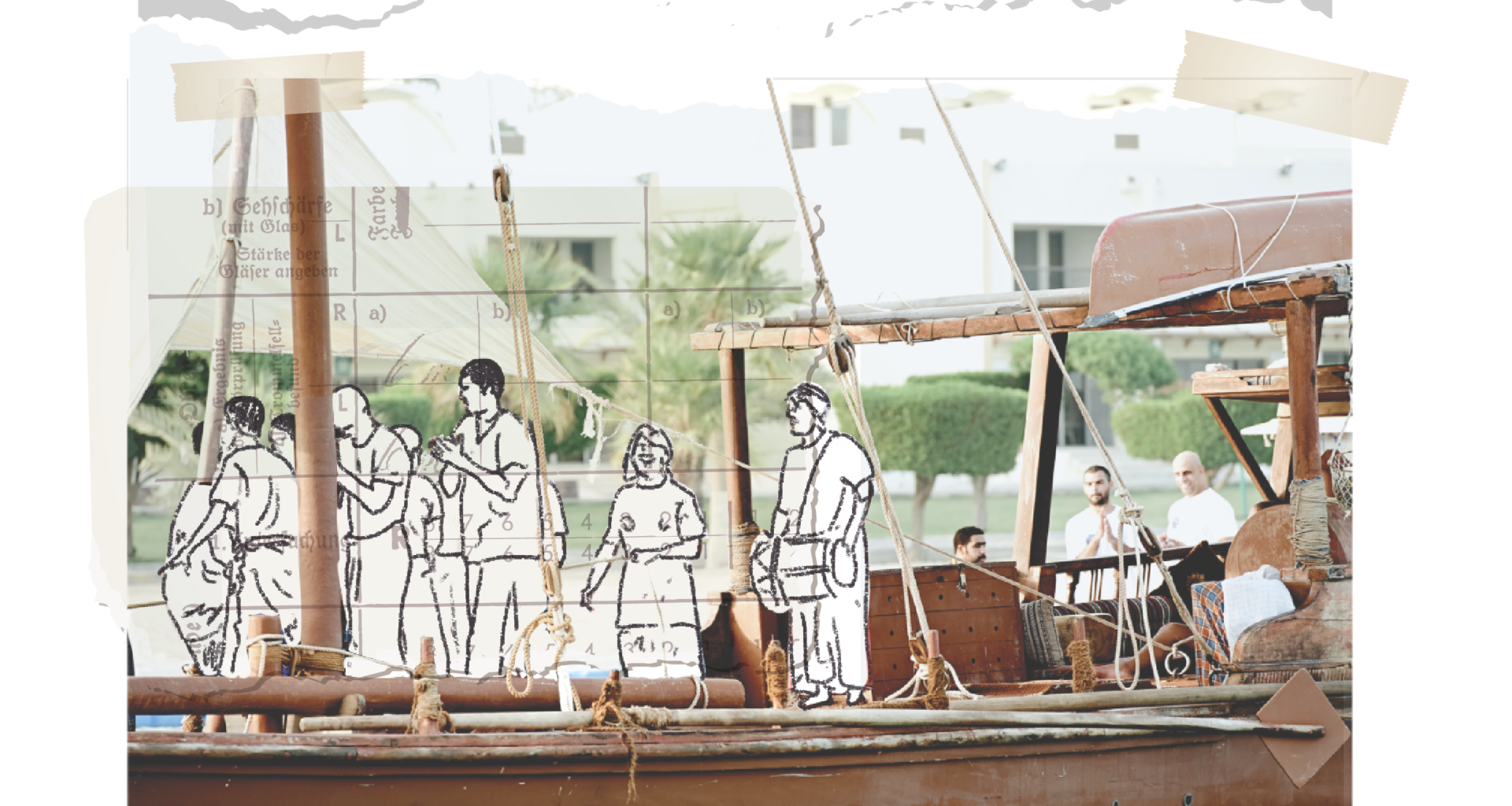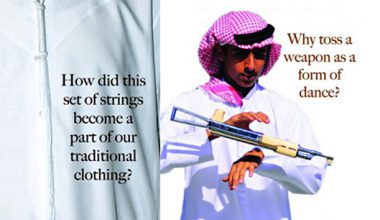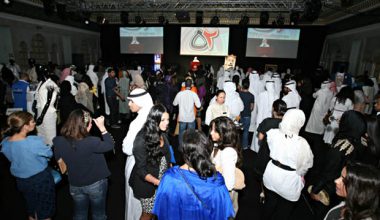Although I was born in Kuwait, my father was a diplomat and I was raised in Syria, Japan, Germany, Argentina, and the U.S.A. between 1979 and 2014. Having spent the majority of the last 35-years abroad, I moved to Kuwait in September of 2014 where I currently work as a professor of music in addition to leading Boom.Diwan,1 my modern Kuwaiti-music ensemble.
In order to historically contextualize my mission with Boom.Diwan, we will first have to start at the year of the Iraqi invasion when I was thirteen years old and my father was stationed in the Kuwaiti Embassy in Bonn, Germany. My grandfather also came to Bonn and lived with us until the end of the invasion. He and I shared a deep bond of respect and friendship. One day, as I was waiting for family-lunch to begin, I noticed that my grandfather was wearing an article of clothing that was foreign to me. When I asked my father what it was, he responded: “It is a wizar; your grandfather was a nokhidha.” “What is a nokhidha?” I asked. “A shipmaster!” my father replied.
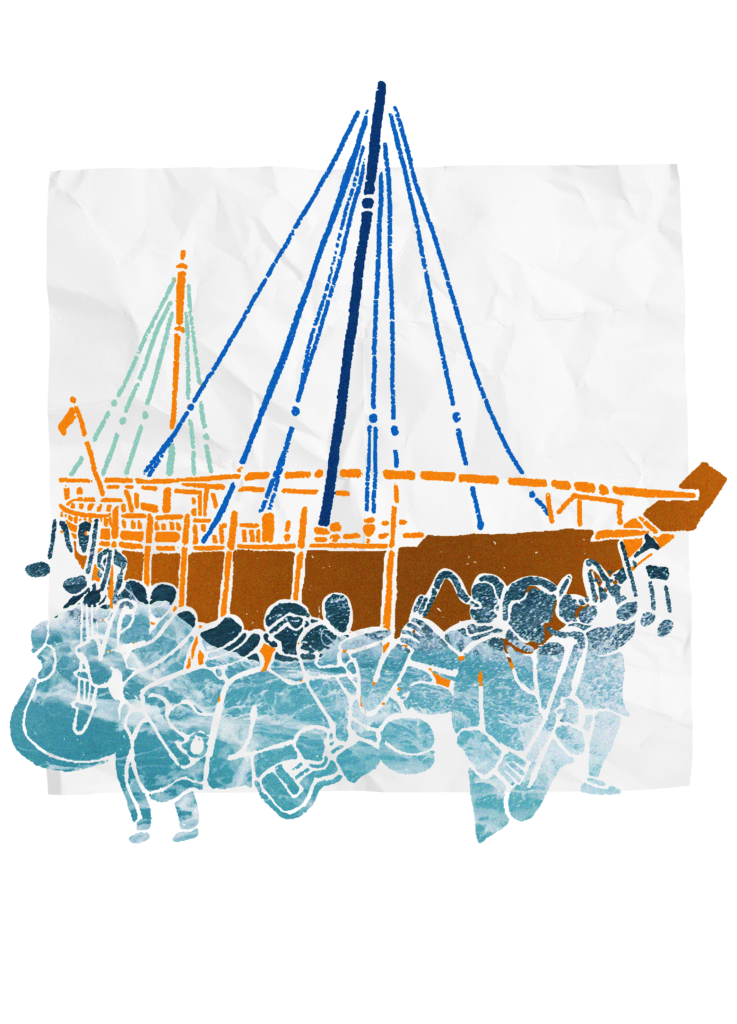
I was overcome with excitement and wonder at the discovery of my grandfather’s life as a shipmaster. Eventually, I found out that he was a pearl-diver and maritime-merchant as well. On the only occasion that I had asked him about his life at sea, he replied: “All the Men died at sea.” I pressed him twice more on that same occasion and received the same answer, “All the men died at sea.” Although I never asked again, his silence and mourning disposition instilled in me a tremendous curiosity about his previous life at sea, and our family’s place in Kuwaiti maritime history.
I attempted to uncover information about my family’s history by conducting ethnographic interviews with the elders in my family. What I discovered was that my family originally resided in a neighborhood called, Fireej Saud, in an old Kuwaiti town called Qibla. They called us al-nowakhida, or the shipmasters. As I continued my research, I found the work of the Kuwaiti historian Sayf Marzouq Al-Shamlan. In his book Pearling in the Arabian Gulf: A Kuwaiti Memoir,2 he stated the Al-Mulaifi family were among the last three Kuwaiti families still pearl-diving and trading pearls until pearl-diving was officially outlawed in 1955. These discoveries influenced the next decade and a half of my life’s work. Starting, in the fall of 2008, I was awarded a MacCracken Fellowship to attend New York University (NYU) where I began my career as an ethnomusicologist. In my doctoral dissertation, Al-Kout and the Sea: An Inquiry into the Production of Kuwaiti Maritime Heritage, I posed the central question, “what happens to tradition when it is absorbed as cultural heritage functioning as an authorized heritage discourse?”3 From that inquiry and two years into my graduate school research, I came upon an article in the New York Times titled, Diving for Pearls, and a Connection to the Past.4 There I read about the late nokhidha Khalifa
Al-Rashed (may he rest in peace) and how he taught young Kuwaiti boys how to pearl dive in annual government-sponsored pearl diving expeditions. After reading the article I called my father from New York to see if it would be possible for me to join me in the next expedition so that I could conduct ethnographic fieldwork for my dissertation. After gaining approval to participate in the pearl diving expedition of 2012, I asked my friend and professional photographer, Mike Kreuger,5 to join me in visually documenting the expedition. In addition to the rich ethnographic fieldwork that took place, nokhidha Al-Rashed, taught us both how to pearl dive; an experience by way of ritual and contemplation that symbolically connected me to my sea-faring ancestors. The corporeal transmission of knowledge from Al-Rashed to myself took the same pedagogical approach that was used to teach the Kuwaiti pearl divers in the past. After a life’s work in dedication to preserving our pearl-diving traditions, Al-Rashed passed away in 2018 (may he rest in peace).
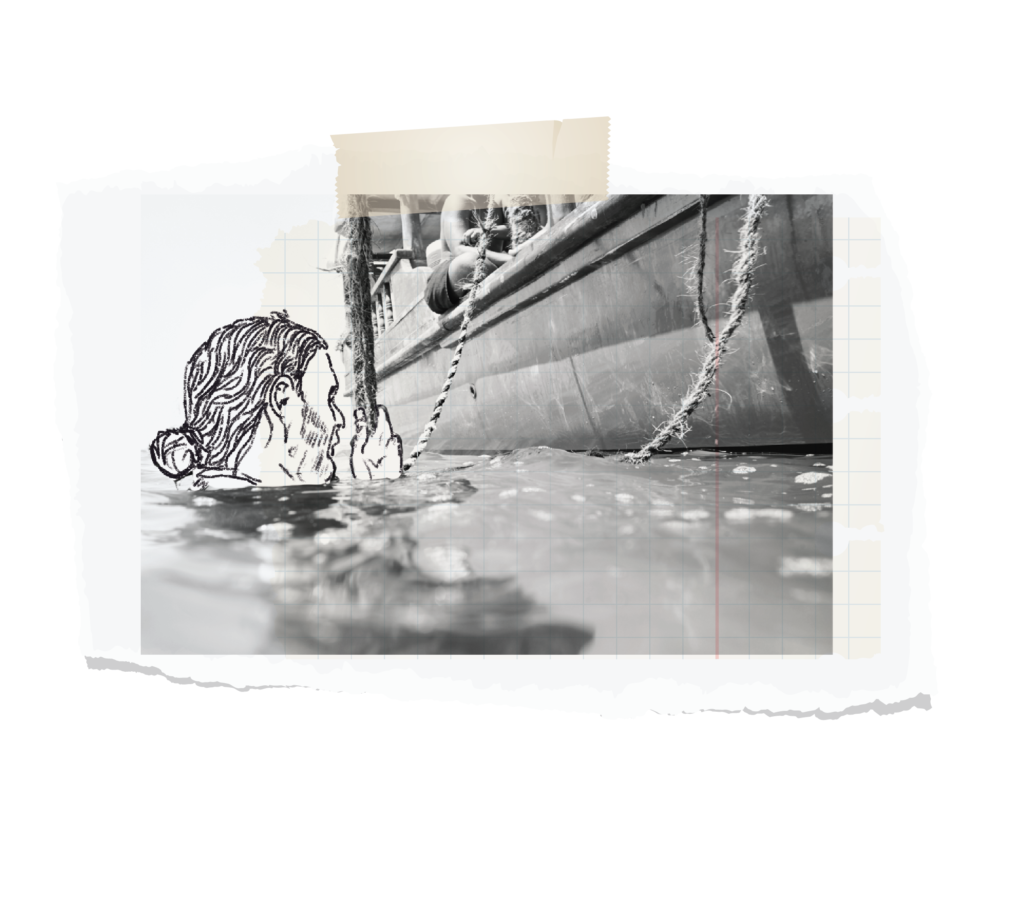
Upon graduating and returning to Kuwait, I contacted a man named Abdulaziz Al-Hemely who was a main interlocutor during the pearl diving expedition of 2012. Today he is the nahaam6 of the Mayouf Mejally Folkloric Ensemble (MMFE), and authorized by the Kuwaiti government to teach pearl diving music to the youth at the Kuwait Sea Sport Club. I informed Al-Hemely that New York University in Abu Dhabi (NYUAD) had contacted me about writing an ethnographic piece about the MMFE and requested that they perform at NYUAD. Al-Hemely organized a meeting between myself and Sulaiman Mayouf Mejally, who leads the MMFE. Over the next two years, I conducted ethnographic interviews with the MMFE in their diwaniya. In March of 2015 I was invited to a conference about the music of the Arabian Gulf at NYUAD where I presented an ethnographic paper about their family’s history. After my presentation, they performed for a live audience of students, professors, and guests.7
When we returned to Kuwait, Al-Hemely and I continued recording Kuwaiti sea rhythms in my home studio. Occasionally however, I would bring out my guitar and we would informally make music together for our own enjoyment. On one of these particular evenings, he had asked me if I would consider sharing some of my compositions with Sulaiman Mayouf and two other MMFE members who also happened to be participants in the pearl-diving expedition. Al-Hemely set up the meeting at the Mayouf Mejally diwaniya in Al Rawda. As we drank tea, I asked Sulaiman, “Are you sure it is acceptable to dialog global jazz with Kuwaiti Bahri music?”8 Sulaiman responded, “This is not the Quran.” Coming from the leader of MMFE, it was a moment that gave me the license and the freedom to dive deep and experiment respectfully with Kuwaiti Bahri music. I decided that an applied ethnomusicological approach to this music would inspire the revival of a traditional Kuwaiti music-making ensemble. Looking back now, and although I did not know it, Boom.Diwan was born.
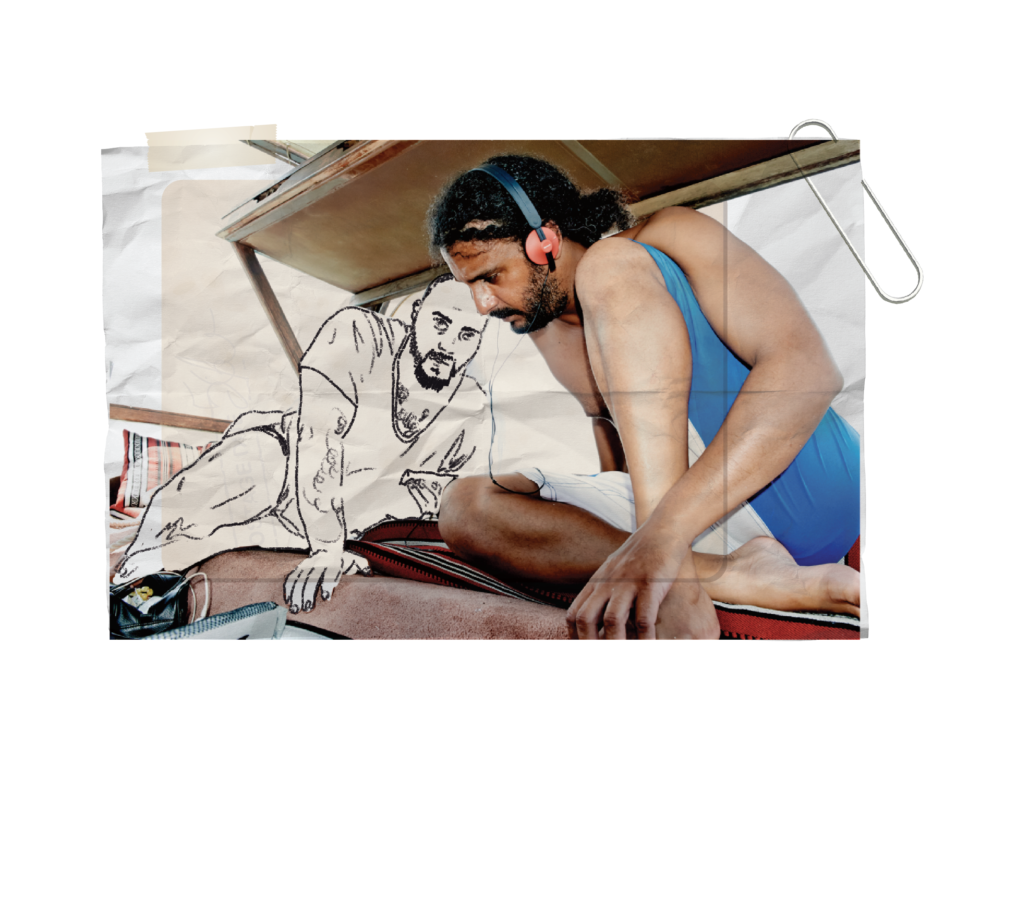
Boom.Diwan
The meaning behind the name Boom.Diwan’s name is inspired by two ideas. First, the Boom, which is considered the most important dhow in Kuwaiti history. There were two types of booms; a smaller one used for pearl-diving along the Arabian Gulf, and a much larger one for maritime trade along the Indian Ocean civilization trade-routes (spanning Northeast Africa and India). For my ensemble, the boom acts a metaphor for the musical and cultural dialogs and exploration that Boom.Diwan engages in. While the [music] Diwan, in this context, is the social space in the homes of Kuwaitis where pearl diving families perform, preserve, and transmit traditional Kuwaiti bahri music from generation to generation. For us, Diwan reference alludes to welcoming the collaboration between Boom.Diwan and other musical traditions regardless of genre.
Historically, after pearls were harvested in the Arabian Gulf, they were traded by Kuwaiti maritime-merchants in locations along the Indian Ocean civilization trade routes. During the period when shipmasters sold their pearls for goods, the sailors waited for months for the trade-winds to changed direction so that they could sail back to Kuwait. During this interim, the sailors would engage musically with the local seaport communities where they were docked. And upon returning to Kuwait they would share new songs, rhythms, and imported instruments from their travels that were eventually absorbed into the fabric of the local cultural and musical community. With each pearling and trading season, Kuwaiti bahri music evolved until pearl-diving was outlawed in 1955. Consequently, bahri music in its fluid state, which was occasioned by dialogue and exchange, was transported from a traditional aquacultural lifeway to a symbol of national identity as cultural heritage when Kuwait became a country-state.
If the state of bahri musical heritage in Kuwait is static, we must understand that its evolution in the modern age necessitates the same openness, fluidity, and exchange that occasioned it. This was the seed that inspired Boom.Diwan to take music from the Kuwaiti bahri repertoire and engage it in a global dialog. It is also a respectful bow to our ancestors who benefited culturally, socially, and economically from the openness experienced within the context of trade along Indian Ocean civilization trade routes.
Today the great care-takers of our bahri musical traditions are: Mayouf Mejally, Bin Hussein, and Al-Amiri families. Boom.Diwan’s mission is to take these traditions and respectfully, fearlessly, and playfully release them into a global dialog. This is not about the trope of preserving music before it is lost; it is about reviving a music making tradition before it is completely and politically absorbed as cultural heritage.
In the fall of 2018, Bill Bragin, the executive arts director of the Arts Center at NYUAD invited Boom.Diwan to collaborate with six-time Grammy award winning artist, Arturo O’Farrill and the Afro Latin Jazz Orchestra (AFLO). Arturo was uncovering long forgotten bridges between Afro-Cuban music and Afro-Khaleeji music. Based on his research from the book, Cuba and its Music,9 O’Farrill explained how Arabian Andalusia was the bridge between Afro-Cuban and Afro-Khaleeji music. In September of 2018, O’Farrill and Bragin spent three days in my diwaniya in Kuwait where O’Farrill and Boom.Diwan had begun to forge a dialog between O’Farril’s Afro-Cuban and our Kuwaiti bahri music. Toward the end of his visit and as I drove O’Farrill to back the airport, he graciously invited Boom.Diwan to collaborate and perform with his Orchestra at the culmination of his upcoming residency in The Arts Center at NYUAD.
In February of 2019 Boom.Diwan performed my compositions with Arturo O’Farrill and the Afro Latin Jazz Orchestra to a sold-out audience in the Arts Center at NYUAD.10 The cultural and musical exchange between our ensembles was deep. There was a familiarity in the rhythms and the phrasing of the musical sentences. We were open to being influenced by them as they were equally open to being influenced by us. For Boom.Diwan, this collaboration marked a revival of traditional bahri Kuwaiti music-making. It was a moment when we took our traditional music and put it back into the dialogic situations that occasioned it. The dialog that occurred during the Cuban-Khaleeji Project has set a precedent for future Boom.Diwan collaborations.
My journey began with one statement: “All the men died at sea “. My curiosity, research, and applied ethnomusicological work, connected me to my ancestral past. I realized that in their own right, my ancestors were global citizens, traders, and survivors. They were explorers with no choice but to trade with the other or perish. With neither a context for the nation-state, let alone theories about heritage, they experienced a great freedom at the cost of comfort; comfort, that today, breeds complacency at the cost of progress.
Although Bahri music in Kuwait was historically forged of dialog, change, and the need to survive, today it has been appropriated as cultural heritage and with Boom.Diwan, we have set it free.
Notes:
- http://boomdiwan.com
- Shamlān, Sayf Marzūq., and Peter Clark. Pearling in the Arabian Gulf: a Kuwaiti Memoir. London Center for Arab Studies, 2001.
- Smith, Laurajane. Uses of Heritage. Routledge, 2010.
- Fahim, Kareem. “Diving for Pearls, and a Connection to the Past.” The New York Times, The New York Times, 13 Aug. 2010, www.nytimes.com/2010/08/13/world/middleeast/13kuwait.html?linked=google.
- Kreuger, Mike. “People/Portrait.” Mike Krueger [Photographer], www.kruegermike.com.
- A nahaam is the singer on a pearl diving expedition.
- http://www.youtube.com/watch?v=i_uOISb1eT8
- Bahri: An Arabic term that means “of the sea.”
- Sublette, Ned. Cuba and Its Music: FROM THE FIRST DRUMS TO THE MAMBO. Non-Approval Trade, 2007.
- https://www.youtube.com/watch?v=i_uOISb1eT8
A version of this article was featured in Khaleejesque’s September 2019 issue.
Words: Ghazi Faisal Al Mulaifi
Illustrations: Bayan Dahdah

